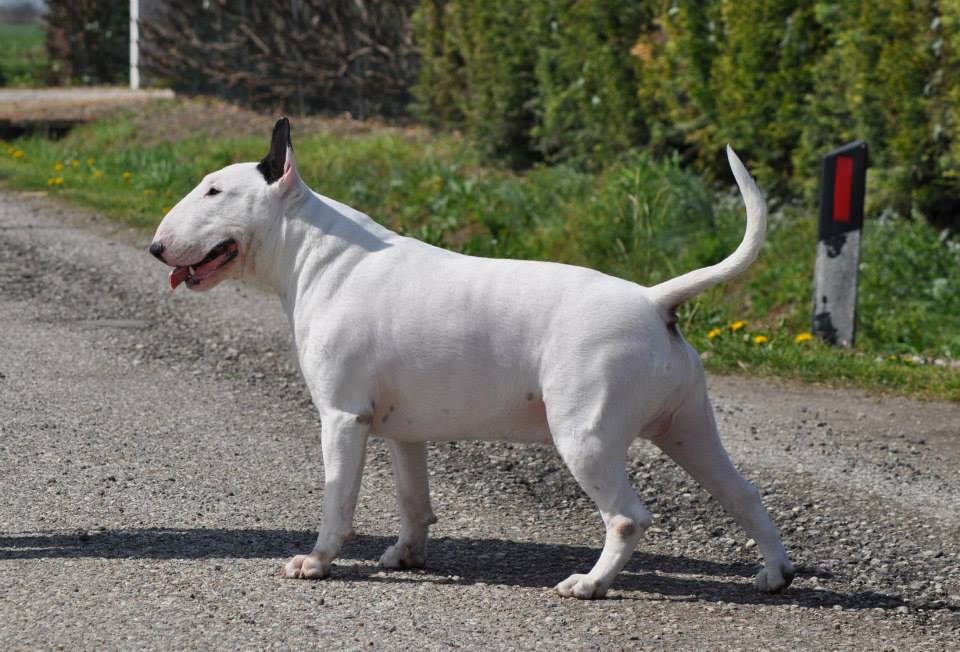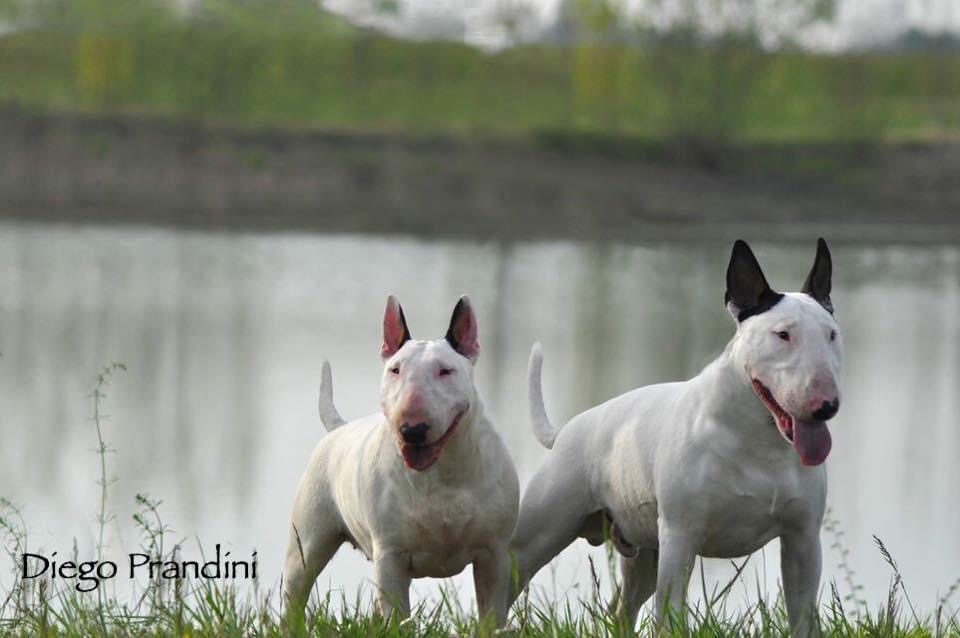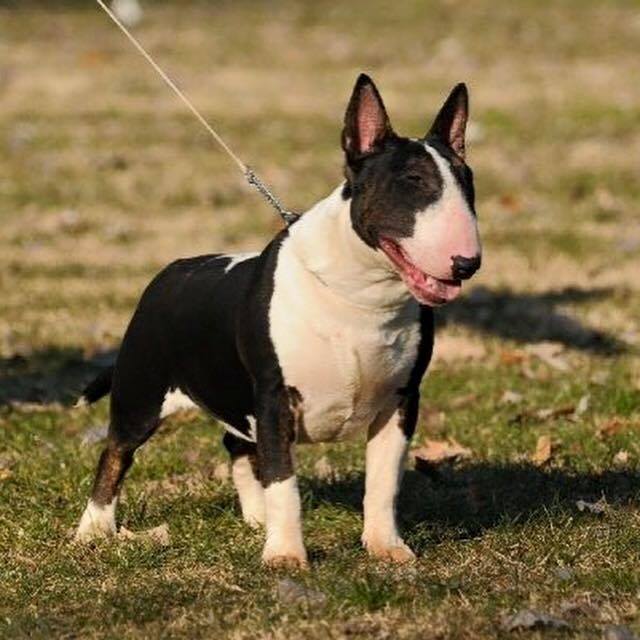
| La nascita della razza Nell’Ottocento in Inghilterra, uno dei divertimenti più diffusi erano i combattimenti tra cani. Proprio in questo periodo inizia la storia del Bull Terrier. All’epoca erano utilizzati i “Bull”, cani combattivi e guerrieri, selezionati unicamente per il combattimento, che avevano come avversari anche orsi e tori. Al fine di migliorare le doti di resistenza, agilità, scioltezza si fecero accoppiare i Bulldog dell’epoca con cani Terrier; da qui la nascita del Bull & Terrier, cane senza rivali fino alla fine dell’Ottocento. La nascita del Bull Terrier odierno è dovuta ad un allevatore di Birmingham, James Hinks, che verso il 1860, rese la razza più agile. Originariamente il Bull terrier derivava da antichi incroci tra il Bulldog ed il Fox terrier e solo successivamente, e pare proprio a opera di Mr. Hinks, venne immesso sangue di Dalmata e di altri terrier inglesi bianchi. Dopo anni di selezione nacque quindi il Bull Terrier conosciuto oggi, che, nonostante la fierezza e l’aspetto del forte combattente, sa dare affetto, fedeltà e tenerezza. Deve essere guidato da un padrone deciso, che sappia smussare l’irruenza del suo carattere. Sa essere obbediente e protettivo, tranquillo se circondato dalle persone della famiglia e conosciute, guardiano verso gli estranei . E’ un cane che ha bisogno di un padrone attivo, di spazio per muoversi ma che non disdegna sane dormite sul divano. |
| Origine e classificazione Origine: GranBretagna – Classificazione F.C.I.: Razza 123 – Gruppo 3 – terriers. Fa parte dei Terrier di tipo Bull assieme a: Staffordshire Bull Terrier, American Staffordshire Terrier e American Pit Bull Terrier (quest’ultimo non ancora riconosciuto FCI) Aspetto Il Bull Terrier è un cane di media taglia compatto e robusto, mesomorfo mesocefalo. Ha una solida costituzione forte e muscolosa. La particolarità che lo contraddistingue è l’inconfondibile testa. L’ espressione è intelligente e decisa. Esiste una versione della razza di dimensioni più ridotte: il “Bull Terrier Miniature”. Standard Altezza e peso: nello standard non sono indicati limiti di peso e di altezza. Il cane dovrebbe esprimere il massimo della potenza nel minimo spazio. Tronco: deve essere tondeggiante, con una grande profondità. Il dorso deve essere corto. Il torace, visto dal davanti, deve apparire largo. Testa e muso: è una delle principali caratteristiche della razza: deve essere lunga, con assi cranio-facciali divergenti. La testa deve presentarsi forte e profonda all’estremità del muso, perfettamente piena; mai grossolana. La parte superiore del cranio, tra le orecchie, deve essere piatta. Il profilo della testa si deve incurvare dalla sommità del cranio fino alla punta del naso, preferibilmente nera. La testa deve essere proporzionata al corpo del cane, la sua forma e dimensioni sono molto importanti: la definizione “Roman finish” richiede un profilo pulito, curvo con un’ultima inclinazione finale. Tartufo: largo e di colore nero. Occhi: vicini, piazzati obliquamente, ben infossati preferibilmente di colore nero o marrone scuro. Denti: regolarmente allineati e completi nel numero e nello sviluppo. La chiusura deve essere a forbice. Orecchie: piccole, fini e vicine tra loro. Devono essere portate erette rigidamente. Collo: molto muscoloso, lungo, arcuato e ben definito. Arti: sia i posteriori che gli anteriori devono essere in appiombo. Ossatura di tipo rotondo. Di moderata lunghezza. Piede: piccolo “da gatto” Spalla: deve essere forte e muscolosa, senza pesantezza.Muscolatura: forte e sviluppata in tutte le parti del corpo. Linea superiore: diritta e solida. Coda: piazzata bassa, corta e portata orizzontalmente. Pelo: piatto e uniformemente corto. Duro al tatto. Pelle: si adatta saldamente al corpo. Colori ammessi: preferibile bianco, ma tollerato anche colorato, soprattutto tigrato. |
| Commento allo standard Siamo appassionati alla razza da anni ed, ovviamente, abbiamo qualche preferenza. Esistono, in base alle varie linee di sangue, allevamenti ecc, diverse varianti allo standard. Noi amiamo il bull basso e corto, molto muscoloso e compatto…la cosiddetta “palla di cannone”. Proveremo a dirigere la nostra selezione su questa strada, cercando di scegliere nel modo migliore i maschi e le femmine, in modo da enfatizzare queste caratteristiche fisiche, senza dimenticare un altro importante aspetto: il carattere. |

| Salute Il bull terrier è un cane robusto e forte, che per le sue caratteristiche fisiche e caratteriali negli anni si è guadagnato il soprannome di “gladiatore” delle razze canine. Ci sono purtroppo, come per tutte le razze, alcune patologie tipiche della razza a cui bisogna fare molta attenzione in selezione e di cui bisogna essere al corrente prima di scegliere un bull terrier come compagno per la vita Ironbullgladiators da anni si appoggia ai propri veterinari di fiducia per la valutazione dei soggetti da portare in riproduzione, se necessario appoggiandosi anche a varie cliniche del nord Italia. Conserviamo accuratamente i test e le valutazioni veterinarie anche dei nostri soggetti utilizzati in passato e siamo in contatto con la stragrande maggioranza delle famiglie che possiedono nostri soggetti, per poter essere informati anche di eventuali patologie, problemi riscontrati durante gli anni ed avere a nostra disposizione uno storico da analizzare nello studio della genealogia dei nostri cani. Patologie cardiache Il bull terrier può presentare problemi cardiaci, la cui trasmissione è ereditaria per cui in selezione si valuta accuratamente di non utilizzare soggetti che abbiano presentato questo tipo di problematiche o che non ne abbiano famigliarità, tramite test dedicati. Patologie renali Il bull terrier può essere soggetto anche a problemi renali, anch’essi a trasmissione genetica, specie la sindrome da rene policistico: PKD. Recentissimamente sono diventati disponibili test genetici di laboratorio per la PDK e negli accoppiamenti futuri sicuramente utilizzeremo questa risorsa, per quanto riguarda il passato, per nostra grandissima fortuna non riscontriamo una incidenza di questa patologia nella nostra selezione, nella speranza che non ci capiti mai in futuro. Displasia renale: negli anni abbiamo sempre controllato tramite ecografia ed esame UPC i nostri soggetti prima di portarli in riproduzione, pensiamo che la displasia renale sia veramente una delle piaghe della razza, anche se in oltre dieci anni di allevamento abbiamo riscontrato pochissimi casi. Patologie dermatologiche Questo tipo di patologie non mettono a rischio la vita del cane ma impongono una cura particolare di molti fattori, prima di tutti l’alimentazione. I bull terrier necessitano di un’alimentazione particolare e molto curata: si dovranno scegliere cibi con formulazione ipoallergenica e/o monoproteica (unica fonte proteica da pesce o da carne), tenendo d’occhio anche le percentuali di mais e altri cereali che potrebbero facilitare l’insorgenza delle dermatiti. C’è sicuramente una componente genetica ed ereditaria, negli anni abbiamo escluso dalla riproduzione soggetti che risultavano delicati o con problematiche dermatologiche ricorrenti. Acrodermatite letale Dermatosi presente particolarmente alle estremità. La prognosi della malattia è infausta, poiché i cani spesso muoiono oppure vengono sottoposti ad eutanasia prima dell’età di un anno. Presenta disturbi dermatologici del muso e delle zampe, ritardo di crescita, deformazione ossea delle estremità, difficoltà a mangiare, maggiore facilità nel contrarre infezioni microbiche dovuta alle lesioni cutanee e al deficit immunitario severo del cane. Per alcuni cani di 6 mesi o più: infiammazioni della plica di cute in corrispondenza dell’unghia (paronichia), infiammazioni dermatologiche, ma anche respiratorie, digestive, ispessimento della pelle (ipercheratosi) dei cuscinetti, disturbi oculari e/o cardiaci. E’ una malattia terribile che per fortuna fino ad oggi siamo riusciti ad evitare in selezione, finalmente è disponibile un test genetico di ultimissima generazione. Sordità La sordità colpisce più spesso i soggetti completamente bianchi, e può essere mono o bilaterale. Da anni scegliamo accuratamente i riproduttori ed abbiamo deciso di utilizzare sempre uno dei due genitori colorati, o addirituttura entrambi, per ridurre quanto possibile l’incidenza dei soggetti sordi nella nostra selezione. Ingestione di corpi estranei Il bull terrier standard, soprattutto nei primi anni di vita, ma non si esclude che lo faccia per tutta la sua esistenza, ha la tendenza ad ingoiare diverse cose che gli capitano a tiro, dai sassi, ai giochi dei bambini, alle cose più inimmaginabili, per questo motivo è da mettere in conto, se scegliete questa razza, di prestare veramente molta attenzione all’ambiente in cui vivrà il cane e prepararsi, nei casi estremi ad interventi veterinari dedicati a rimuovere i corpi estranei ingeriti bloccati in stomaco ed intestino. Lussazione della rotula (Patella) La lussazione di rotula è una patologia ereditaria che colpisce numerose razze canine di diverse taglie. Compare in giovane età ed è causa comune di zoppia posteriore. Vanno eliminati dalla riproduzione i soggetti che presentano questo problema. LINK SUGGERITI PER L’APPROFONDIMENTO: www.thebullterrierclub.com (Club Officiale Inglese) http://www.canitalia.it/dalcor/dondi/rel.htm (Sordità) https://www.clinicaveterinariacmv.it/blog/lussazione-della-rotula-nel-cane-sintomi-cura/ (Lussazione della rotula) Acrodermatite letale |
Standard, story & health information
| Breed Standard — Bull Terrier Kennel Club England General appearance Strongly built, muscular, well balanced and active with a keen, determined and intelligent expression. Characteristics The Bull Terrier is Courageous, full of spirit, with a fun loving attitude. A unique feature is a downfaced, egg shaped head. Irrespective of size dogs should look masculine and bitches feminine. Temperament Of even temperament and amenable to discipline. Although obstinate, is particularly good with people. Head and Skull Head long, strong and deep right to the end of muzzle, but not coarse. Viewed from front, egg-shaped and completely filled, its surface free from hollows or indentation. Top of skull almost flat from ear to ear. Profile curves gently downwards from top of the skull to tip of nose, which should be black and bent downwards at tip. Nostrils well developed and under-jaw deep and strong. Mouth Teeth sound, clean, strong, of good size, regular with perfect, regular and complete scissor bite, i.e. upper teeth closely overlapping lower teeth and set square to the jaw. Lips clean and tight. Eyes Appearing narrow, obliquely placed and triangular, black or as dark brown as possible so as to appear almost black, and with a piercing glint. Distance from tip of nose to eyes perceptibly greater than that from eyes to top of skull. Blue or partly blue undesirable. Ears Small, thin and placed close together. Dog should be able to hold them stiffly erect. When they point straight upwards. Neck Very muscular, long, arched, tapering from shoulders to head and free from loose skin. Forequaters Shoulders strong and muscular without loading. Shoulder blades wide, flat and held closely to the chest wall and have a very pronounced backward slope of front edge from bottom to top, forming almost a right angle with upper arm. Elbows held straight and strong, pasterns upright. Forelegs have strongest type of round quality bone, dog should stand solidly upon them and they should be perfectly parallel. In mature dogs, length of foreleg should be approximately equal to depth of chest. Body Body well rounded with marked spring of rib and great depth from withers to brisket, so that latter nearer ground than belly. Back short, strong with backline behind withers level, arching or roaching slightly over broad, well muscled lions. Underline from brisket to belly forms a graceful upward curve. Chest broad when viewed from front. Hindquarters Hind legs in parallel when viewed from behind. Thighs muscular and second thighs well developed. Stifle joint well bent and hock well angulated with bone to foot short and strong. Feet Round and compact with well-arched toes. Tail Short, set on low and carried horizontally. Thick at root, it tapers to a fine point. Gait/Movement When moving appears well knit, smoothly covering ground with free, easy strides and with a typical jaunty air. When trotting, movement parallel, front and back, only converging towards centre line at faster speeds, forelegs reaching out well and hind legs moving smoothly at hip, flexing well at stifle and hock, with great thrust. Coat Short, flat, even and harsh to touch with a fine gloss. Skin fitting dog tightly. A soft textured undercoat may be present in winter. Colour For white, pure white coat. Skin pigmentation and markings on head not to be penalised. For coloured, colour predominates; all other things being equal, brindle preferred. Black, brindle, red, fawn and tricolour acceptable. Tick markings in white coat undesirable. Blue and liver highly undesirable. Size There are neither weight nor height limits, but there should be the impression of maximum substance for size of dog consistent with quality and sex. Faults Any departure from the foregoing points should be considered a fault and the seriousness with which the fault should be regarded should be exact proportion to its degree. |

HEALTH
The bull terrier is a strong dog, which for its physical and character characteristics over the years has earned the nickname of “gladiator” of dog breeds.
There are unfortunately, as for all breeds, some pathologies typical of the breed to which you have to be very careful in selection and of which you must be aware before choosing a bull terrier as a companion for life
Ironbullgladiators for years relies on their veterinarians for the evaluation of subjects to carry in reproduction, if necessary also relying on various clinics in northern Italy.
We keep carefully the tests and veterinary assessments of our subjects used in the past and we are in contact with the vast majority of families that have our dogs, in order to be informed of any disease, problems encountered over the years and have at our disposal a history to analyze in the study of the genealogy of our dogs.
Heart disease
The bull terrier may have heart problems, whose transmission is hereditary, so in selection it is carefully evaluated not to use subjects who have presented this type of problem or who have no familiarity, through dedicated tests.
Kidney diseases
The bull terrier can also be subject to kidney problems, also with genetic transmission, especially polycystic kidney syndrome: PKD.
Recently laboratory genetic tests have become available for PDK and in future matings we will definitely use this resource, as far as the past, Fortunately for us, we do not find an incidence of this pathology in our selection, in the hope that it will never happen to us in the future.
Renal dysplasia: over the years we have always checked through ultrasound and UPC examination our subjects before bringing them into reproduction, we think that renal dysplasia is really one of the sores of the breed, although in over ten years of breeding we have found very few cases.
Dermatological pathologies
This type of pathologies do not endanger the life of the dog but require special care of many factors, first of all feeding.
Bull terriers need a particular and very accurate diet: you will have to choose foods with hypoallergenic and/or monoproteic formulation (only protein source from fish or meat), keeping an eye on the percentages of corn and other cereals that could facilitate the onset of dermatitis.
There is definitely a genetic and hereditary component, over the years we have excluded from reproduction subjects that were delicate or with recurrent dermatological problems.
Acrodermatitis lethal
Dermatosis is particularly present at the extremities. The prognosis of the disease is poor, as dogs often die or are euthanized before the age of one year. It presents dermatological disorders of the snout and legs, growth delay, bone deformation of the extremities, difficulty in eating, greater ease in contracting microbial infections due to skin lesions and severe immune deficiency of the dog. For some dogs of 6 months or more: inflammation of the skin fold at the nail (paronichia), dermatological inflammation, but also respiratory, digestive, thickening of the skin (hyperkeratosis) of the pads, eye and/or heart disorders.
It’s a terrible disease that fortunately we’ve managed to avoid in selection until now, finally a genetic test of the latest generation is available.
Deafness
Deafness most often affects completely white subjects, and can be mono or bilateral.
For years we have carefully chosen the reproducers and we have decided to always use one of the two colored parents, or even both, to reduce as much as possible the incidence of deaf subjects in our selection.
Ingestion of foreign matter
The standard bull terrier, especially in the early years of life, but it is not excluded that it does so throughout its existence, has a tendency to swallow several things that happen to him at a glance, from stones, to children’s games, to the most unimaginable things, for this reason it is to be taken into account, if you choose this breed, to really pay a lot of attention to the environment in which the dog will live and prepare, in extreme cases to veterinary interventions dedicated to removing the ingested foreign bodies stuck in the stomach and intestines.
Dislocation of the patella (patella)
Patella dislocation is a hereditary condition that affects many dog breeds of different sizes. It appears at a young age and is a common cause of posterior lameness. Subjects with this problem should be eliminated from reproduction.
